This was published 7 years ago
Singapore's National Gallery and arts scene
By Garry Maddox
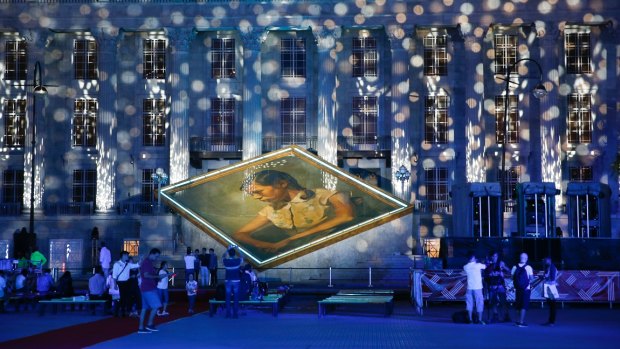
National Gallery Singapore gives a vivid sense of the nation's history as well as its art riches.
It's described as the largest public collection of modern art in south-east Asia. A new landmark for visual arts in the region. But Singapore's National Gallery, which opened in November last year, is virtually a work of art itself.
Two landmark colonial buildings, the old City Hall and Supreme Court, have been blended and restored to create a gallery that gives a vivid sense of the tropical island nation's history as well as its art riches.
Many significant events have taken place on the site since the two buildings, now considered national monuments, opened in 1929 and 1939 respectively. British colonial rule. Occupation by the Japanese during World War II. Surrender to the Allies. The swearing in of Lew Kuan Yew as the country's first prime minister in 1959. Independence in 1965.
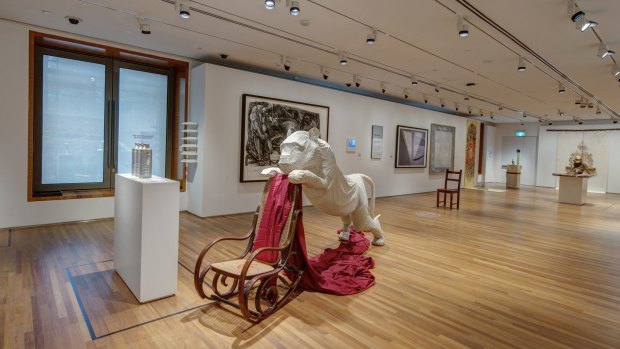
National Gallery Singapore.Credit: National Gallery Singapore
But after French firm Studio Milou Architecture won an international architectural design competition in 2008, the buildings have been combined into a gallery housing 8000 artworks. It attracted more than 170,000 visitors in the first two weeks of opening celebrations.
Rushing into the gallery on a first visit, I took a tour that turned out to be of the buildings rather than the art. But it proved to be a fascinating two hours nevertheless. We visited the grand Supreme Court foyer which has a buried time capsule that is not to be opened until the year 3000; the old holding cells that lead to a courtroom through a clever internal corridor; the rooftop area where a striking glass and metal canopy is supported by tree-like columns; and the beautifully restored City Hall Chamber, where the Japanese signed the surrender document and Lee Kuan Yew took office.
What made this tour more fascinating were the pointed observations, supplementing the commentary by tour guide Irene, from a former Singaporean barrister ("now just a housewife") who was also on the tour. She noted the invading Japanese were the first "non-whites" to use the building, for example. That from the fifth floor verandah, you can see the cricket club where the Indians and Chinese would fan the English. And that, unhappily for a proud Singaporean, another British architect, Norman Foster, had created what she considered an ugly "space ship" addition to the new Supreme Court.
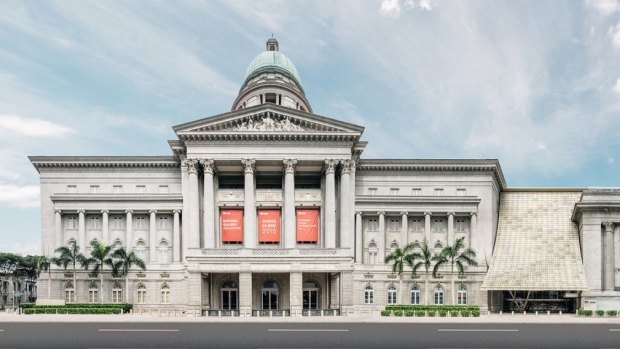
A grand design: The National Gallery Singapore.Credit: National Gallery Singapore
The tour ran well overtime as the former barrister passionately pointed out to this foreign journalist that the Singapore government's support for censorship and the death penalty had underpinned the country's remarkable transformation from the extreme poverty and limited educational opportunities of her mother's youth to the thriving modern nation it is today.
The following afternoon, the gallery tour proved just as fascinating for how the artworks reflected the currents of Singaporean history.
Take the contrast between two nautical paintings from different eras. Robert Wilson Wiber's watercolour Panoramic View of Singapore from the Harbour shows the city through English eyes in 1849. Just 30 years after it became a British colony, the island is viewed as a thriving trading port for both English ships and Chinese junks.
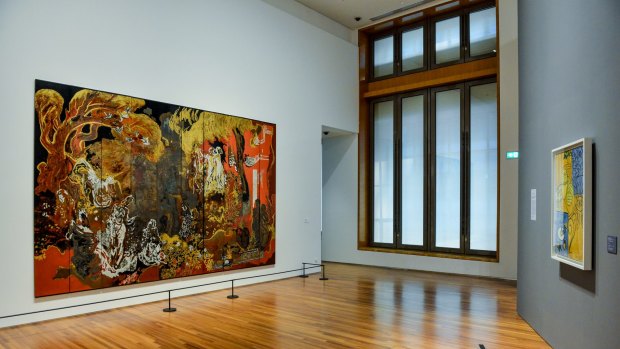
Reframing modernism.Credit: National Gallery Singapore
A wave of artists arriving in the 1920s and '30s brought a fresh perspective, with the country's first art movement, the Nangyang school, tackling local subjects in innovative ways. Chen Wen Hsi's The Ferry, for example, is a bold and vibrant painting through Asian eyes of sarong-clad men on boats from 1952.
In another painting from the 1950s, Singapore's emergence as a nation with its own post-colonialist culture is reflected in Chua Mia Tee's National Language Class. It's a social realist take on an evening class that reflects nationalist feelings of independence.
Then there is the story told by two contrasting artworks featuring fishing nets. While Yip Cheong Fun's print Amidst the Nets shows the elegant beauty of drying nets in a traditional scene from the 1940s, Teo Eng Seng's The Net: Most Definitely The Singapore River is a comically subversive take on these sentimental scenes from the 1980s that is made up of rubbish salvaged from the water.
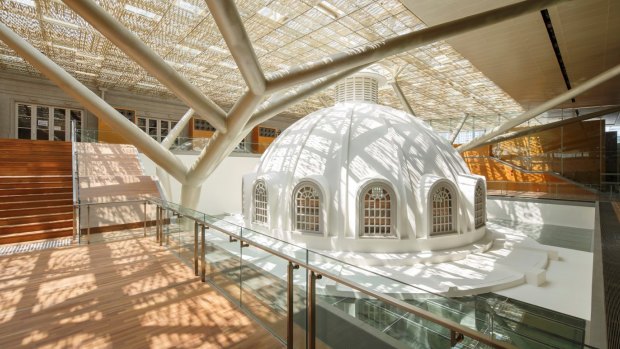
Former Supreme Court rooftop terrace.Credit: National Gallery Singapore
Keep an eye out for one of Singapore's best-known paintings – Cheong Soo Pieng's Drying Salted Fish, a Malay rural scene inspired by Chinese art from 1978. It features on the country's $50 note.
Returning another day for a tour of the South-East Asian Gallery, it's the recurring themes reflecting the region's history that stand out: colonialism, national identity, the tension between cultural traditions and progress, the value of art at times of political turbulence and the relationship between eastern and western methods.
One of the most striking examples in this part of the National Gallery is Indonesian artist S. Sudjojono's Perusing a Poster, which shows a cross-section of ordinary people looking anxiously at something out of frame, while others get on with their lives. It suggests questions over where the nation was heading in the 1950s.
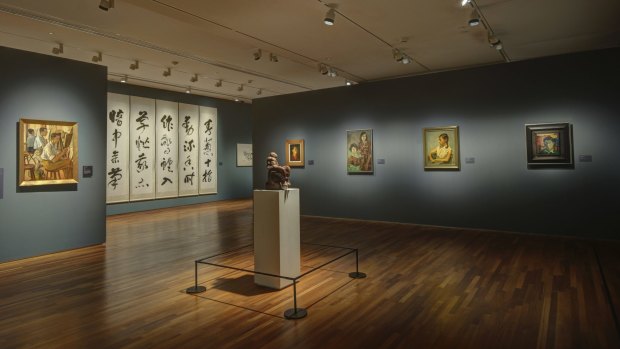
National Gallery Singapore.Credit: National Gallery Singapore
Singapore has many other attractions that will interest tourists interested in appreciating its art.
While the Singapore Art Museum features modern art from around Asia, the Asian Civilisations Museum focuses on artifacts from the country's cultural heritage, including carvings, textiles and jewels.
There are also art events throughout the year.
In January, Singapore Contemporary features collectable art works from more than 90 exhibitors as part of Singapore Art Week. In April and November, the Affordable Art Fair showcases contemporary art from more than 40 galleries. And, on a smaller scale, a bi-monthly Sunday Artists Market features local art and crafts.
There are also less formal ways to discover art in Singapore.
Artist Mohammed Zulkarnaen Bin Othman, one of the founders of an urban art collective who works under the name Zero, suggests the first thing Australian visitors should do to get a sense of the art and culture is just walk around the city.
"Don't go the galleries first," he says. "Look at the people first. Go into the neighbourhoods, even some of the older neighbourhoods that have more character. See how we live our lives.
"Then find the independent art spaces. If you go into the contemporary arts spaces, contemporary art all around the world has pretty much the same feel to it. Maybe the concepts and the context are different but visually it might seem similar, especially when you're talking about Singaporean art.
"Like Melbourne and Sydney, Singapore is very cosmopolitan, a melting pot of different cultures and races and languages, so look at the locals and look at what the locals find to be 'nostalgic' first."
Bin Othman suggests visiting Haw Par Villa, a theme park featuring more than 150 dioramas depicting scenes from mythology and folklore (262 Pasir Panjang Road). Its best-known attraction is the Ten Courts of Hell, which features colourfully gruesome depictions of hell from Chinese mythology and Buddhism.
To get a deeper sense of the culture and history, Bin Othman suggests visiting the Malay neighbourhood Kampong Glam, Little India and Chinatown as well as the National Gallery.
While he specialises in spraypainted work with what he calls a "graffiti-esque aesthetic", don't expect to see it on the streets as we might in Australia.
Singapore has harsh penalties for unauthorised street art – two Germans were sentenced to nine months' jail and three strokes of the cane last year for breaking into a transport depot and spraypainting a train – so it remains an outsider art form and graffiti is painted over. Instead, urban artists exhibit on official wall spaces or during a Street Graffiti festival.
Bin Othman says that working in a country with such restrictions presents challenges for artists to rise above in different ways from how western artists might react.
"All of us face [restrictions on expression] in Singapore, whether you're from theatre or visual arts or music," he says. "A lot of times, it makes us more creative."
Bin Othman says Singaporeans do not like confrontation and the Asian psyche equates being loud and brash with being disrespectful so it is more effective for artists to express themselves through symbolism, nuance and humour.
"It's easier to approach [topics] in a soft manner," he says.
The way Bin Othman sees it, Singapore's art reflects the country's identity: it's a conservative Asian nation with deep traditions (at least for artists like him with Malay roots) in such traditional art forms as batik cloth dyeing and wayang kulit shadow puppets; yet it also has a western, cosmopolitan, globalised economy.
TRIP NOTES
GETTING THERE
Singapore Airlines, Qantas and Emirates are among the airlines that fly from Sydney and Melbourne to Singapore.
STAYING THERE
Hotel Vagabond is a stylish new boutique hotel (39 Syed Alwi Road) next to Little India.
EATING THERE
For a traditional Singaporean breakfast, Ya Kun Kaya Toast (18 China Street). While visiting the National Gallery, Aura is an elegant Italian rooftop restaurant with views from a sky lounge. For chilli crab, Long Beach Main Seafood Restaurant (1018 East Coast Parkway) is a buzzy, down-to-earth experience.
MORE INFORMATION
Yoursingapore.com, nationalgallery.sg
Gary Maddox was a guest of Singapore Tourism
Sign up for the Traveller Deals newsletter
Get exclusive travel deals delivered straight to your inbox. Sign up now.